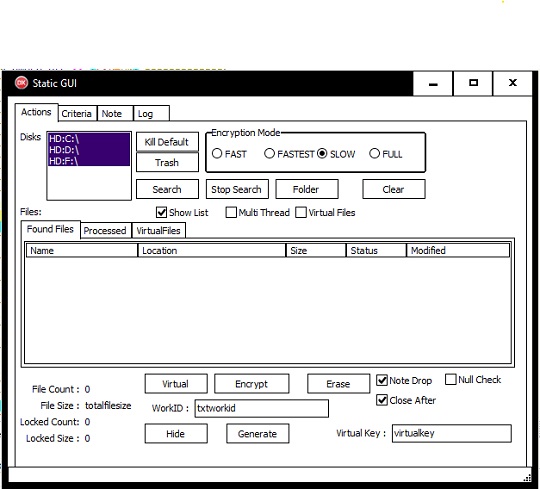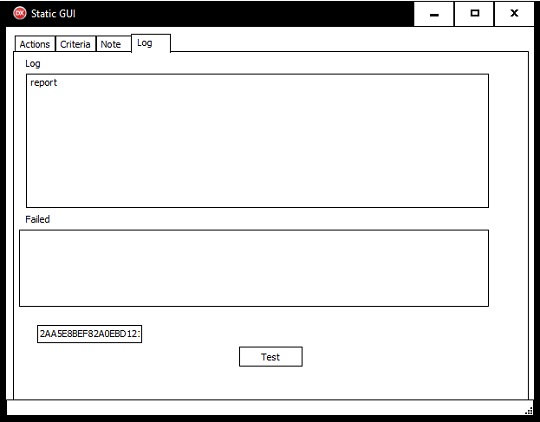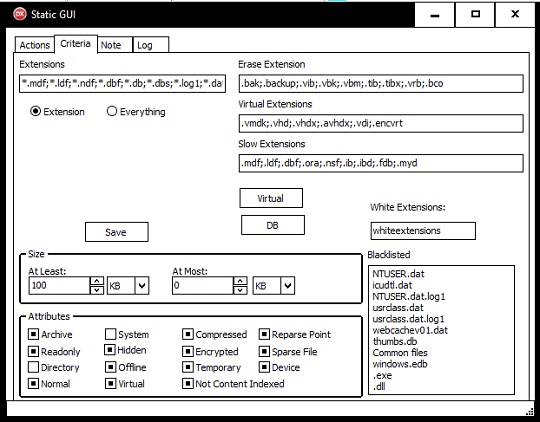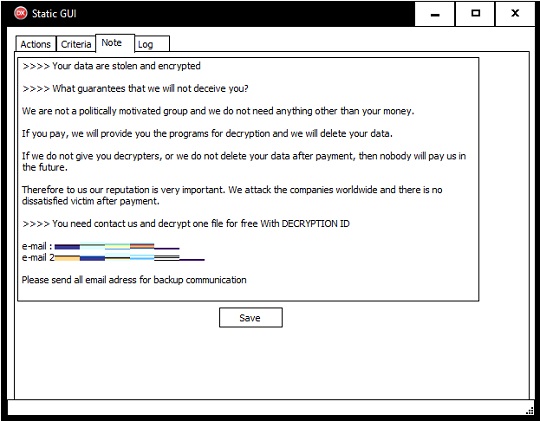Ransom.Win64.ENAMON.THACABD
a variant of Win64/Filecoder.Spacecolon.A trojan (NOD32)
Windows

Tipo di minaccia informatica:
Ransomware
Distruttivo?:
No
Crittografato?:
No
In the wild::
Sì
Panoramica e descrizione
It arrives on a system as a file dropped by other malware or as a file downloaded unknowingly by users when visiting malicious sites.
Dettagli tecnici
Detalles de entrada
It arrives on a system as a file dropped by other malware or as a file downloaded unknowingly by users when visiting malicious sites.
Instalación
Infiltra los archivos siguientes:
- {Malware File Path}\note.txt → deleted afterwards
- {Malware File Path}\ext.txt → deleted afterwards
- {Malware File Path}\SelfDelete.bat → used to delete itself
- {Encrypted File Path}\DECRYPTION_IDS.TXT→ contains decryption IDs
Agrega los procesos siguientes:
- "%System%\cmd.exe\" /C "{Malware File Path}\SelfDelete.bat"
(Nota: %System% es la carpeta del sistema de Windows, que en el caso de Windows 98 y ME suele estar en C:\Windows\System, en el caso de Windows NT y 2000 en C:\WINNT\System32 y en el caso de Windows 2000(32-bit), XP, Server 2003(32-bit), Vista, 7, 8, 8.1, 2008(64-bit), 2012(64bit) y 10(64-bit) en C:\Windows\System32).
)Finalización del proceso
Finaliza los procesos siguientes si detecta que se ejecutan en la memoria del sistema afectado:
- 105.5.5195.102_104.0.5112.81_chrome_updater.exe
- applicationframehost.exe
- audiodg.exe
- dashost.exe
- dllhost.exe
- fiddler.exe
- googlecrashhandler.exe
- googlecrashhandler64.exe
- googleupdate.exe
- microsoftedgeupdate.exe
- mpcmdrun.exe
- msascui.exe
- mscorsvw.exe
- nissrv.exe
- onedrive.exe
- plugin_host.exe
- processhacker.exe
- procmon.exe
- procmon64.exe
- ptsessionagent.exe
- ptwatchdog.exe
- searchindexer.exe
- setup.exe
- sublime_text.exe
- sysmon64.exe
- tabtip.exe
- tabtip32.exe
- taskeng.exe
- tcplogview.exe
- uiwatchdog.exe
- vdisk.exe
- vmacthelp.exe
- vm3dservice.exe
- vserver.exe
Otros detalles
Hace lo siguiente:
- Empties the Recycle Bin
- It displays the following GUI:
- Actions → allows user to:
- Terminate predefined processes.
- Empty the Recycle Bin.
- Select and search drives and folders for files to be encrypted.
- Stop searching drives and folders for files to be encrypted.
- Select encryption mode: FASTEST, FAST, SLOW, FULL.
- Select if found files based on specifications set in the Criteria tab will be displayed.
- Select whether to allow multithreaded encryption or not.
- List found files based on specifications set in the Criteria tab.
- Clear the list of found files based on specifications set in the Criteria tab.
- Encrypt or erase found files based on specifications set in the Criteria tab.
- Select if ransom note is to be dropped.
- Delete the malware file after encryption or when the GUI is closed.
- Hide the GUI.
- Generate/Set WorkID for the ransom note.
- Set a virtual key.

- Criteria → allows user to:
- Specify file extensions that will be encrypted.
- Specify file extensions, file paths, and file names that will not be encrypted.
- Note → allows user to:
- Modify the contents of the ransom note to be dropped.
- Save the contents of the ransom note as {Malware File path}\note.txt.
- Log → allows user to:
- View logs of the malware.



- Actions → allows user to:
Soluzioni
Step 1
Los usuarios de Windows ME y XP, antes de llevar a cabo cualquier exploración, deben comprobar que tienen desactivada la opción Restaurar sistema para permitir la exploración completa del equipo.
Step 2
Note that not all files, folders, and registry keys and entries are installed on your computer during this malware's/spyware's/grayware's execution. This may be due to incomplete installation or other operating system conditions. If you do not find the same files/folders/registry information, please proceed to the next step.
Step 3
Buscar y eliminar estos archivos
- {Malware File Path}\note.txt
- {Malware File Path}\ext.txt
- {Malware File Path}\SelfDelete.bat
- {Encrypted File Path}\DECRYPTION_IDS.TXT
- {Encrypted File Path}\HOW TO RECOVERY FILES.TXT
- {Malware File Path}\note.txt
- {Malware File Path}\ext.txt
- {Malware File Path}\SelfDelete.bat
- {Encrypted File Path}\DECRYPTION_IDS.TXT
- {Encrypted File Path}\HOW TO RECOVERY FILES.TXT
Step 4
Restore encrypted files from backup.
Step 5
Explorar el equipo con su producto de Trend Micro para eliminar los archivos detectados como Ransom.Win64.ENAMON.THACABD En caso de que el producto de Trend Micro ya haya limpiado, eliminado o puesto en cuarentena los archivos detectados, no serán necesarios más pasos. Puede optar simplemente por eliminar los archivos en cuarentena. Consulte esta página de Base de conocimientos para obtener más información.
Sondaggio

